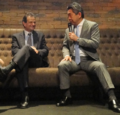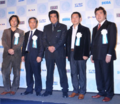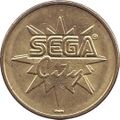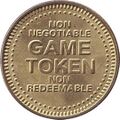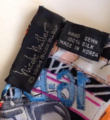Difference between revisions of "CartridgeCulture/To do"
From Sega Retro
m (→General) |
|||
| Line 20: | Line 20: | ||
*FORMATTING: Keep People pages' portraits consistent, meaning make a rule: Do we stick with Sega-relevant photos when possible? Should be use photos from around when they worked at Sega? Again, maybe when possible to keep things relevant, but there are gonna be literally hundreds of pages where that might not be possible. Still, would be nice to have a basic guideline like "If there's a Sega-relevant photo that representative and not horribly low-resolution/unflattering/etc, use it. If not, proceed as normal." Iunno. | *FORMATTING: Keep People pages' portraits consistent, meaning make a rule: Do we stick with Sega-relevant photos when possible? Should be use photos from around when they worked at Sega? Again, maybe when possible to keep things relevant, but there are gonna be literally hundreds of pages where that might not be possible. Still, would be nice to have a basic guideline like "If there's a Sega-relevant photo that representative and not horribly low-resolution/unflattering/etc, use it. If not, proceed as normal." Iunno. | ||
*Dina Sanichar probably belongs in the "Games starring real people" category, but do a little more research before adding him. EDIT: Ehhh... Looks like Mowgli was created using a bunch of sources, with Sanichar (likely) being foremost. Snow White's a little more "Hey it's her", but... this one, I don't know. And wow I can't believe this requires more research. Okay, this is what I'm doing now I guess. | *Dina Sanichar probably belongs in the "Games starring real people" category, but do a little more research before adding him. EDIT: Ehhh... Looks like Mowgli was created using a bunch of sources, with Sanichar (likely) being foremost. Snow White's a little more "Hey it's her", but... this one, I don't know. And wow I can't believe this requires more research. Okay, this is what I'm doing now I guess. | ||
| + | *Get someone to reply to that guy from Sonic Retro's ''[[Boozometer]]'' post (he's trying to share pictures with us but my replies aren't being posted. As long as someone gets in touch with him...) | ||
*Put [https://web.archive.org/web/20030620080723/http://www.sega.co.jp/joypolis/tjp_icbiy.html I Can't Believe It's Yogurt] in WierdThings? with like- exactly that description too. | *Put [https://web.archive.org/web/20030620080723/http://www.sega.co.jp/joypolis/tjp_icbiy.html I Can't Believe It's Yogurt] in WierdThings? with like- exactly that description too. | ||
Revision as of 02:34, 1 December 2021
- Back to: CartridgeCulture.
Contents
- 1 General
- 2 Lists
- 3 Links and stuff
- 4 People to email
- 5 Ideas
- 6 Group photos which need people tags
- 7 Images to incorporate
- 8 Sega Girls Task Force
- 9 Mega Club
- 10 Nicole Miller tie/scarf/cummerbund set
- 11 List of Developer Technical Support/misc employees
- 12 List of Sega of America Game Counselors
- 13 List of related coworkers
- 14 People who need articles
- 15 Read-Only Memory (publisher)
General
- RETROCDN: Migrate Sonic stuff, figure out image tags being pulled elsewhere, upload merch photos from here and here.
- RETROCDN: Replace File:Hiroshi Kawaguchi.jpg with higher resolution/uncropped version.
- IMAGES: Create dedicated Content/Pictured/etc section for tags, and Top/Bottom row subsections for group photos.
- IMAGES: Photograph that Sega VR promotional book. SERIOUSLY JUST GET IT OUT AND TAKE THOSE HONKIN PICTURES ALREADY YOU DANG PROCRASTINATOR
- IMAGES: Photograph that Nicole Miller tie/scarf/cummerbund set, and get a page up.
- IMAGES: Go to that store on Rainbow and see if they still have those Fighting Masters trading cards. If so, buy them and scan/photograph them.
- PEOPLE: Pull Tetsuya Mizuguchi photos from those three articles.
- PEOPLE: Pull biographies from Developmental.
- PEOPLE: Add GoodReads profiles to authors.
- PEOPLE: Date all Michael Jackson and Steven Spielberg tour photographs.
- PEOPLE: Ensure consistent formatting of company roles across people pages.
- PEOPLE: Ensure all celebrity endorser article/image tags are marked as endorser and not licensor.
- PEOPLE: Even if its redundant, add developer links to person-tagged photos with summaries.
- FORMATTING: To what extent are author names and/or quote contexts italicized? We generally do the whole line, standards say to do either the person/source quoted alone, but OTHERS say not to italicize the source name whatsoever. Personally? Feels strange to italicize anything outside the main quote body, but hey I didn't invent the rules. Regardless, figure out which is more accurate/correct/best for our purposes, then think hard on it before getting quotes corrected.
- FORMATTING: Unitalicize any events I've previously italicized.
- FORMATTING: Makes a "Roles" section on this page for defining and unifying People pages' roles. And always order roles in the order in which that person did the most notable work at the company. Ex: art directors. They're "artist and director", not the other way around. I'm guilty of this on a looottt of pages, so get to work once all the big notable employee pages are finished.
- FORMATTING: Keep People pages' portraits consistent, meaning make a rule: Do we stick with Sega-relevant photos when possible? Should be use photos from around when they worked at Sega? Again, maybe when possible to keep things relevant, but there are gonna be literally hundreds of pages where that might not be possible. Still, would be nice to have a basic guideline like "If there's a Sega-relevant photo that representative and not horribly low-resolution/unflattering/etc, use it. If not, proceed as normal." Iunno.
- Dina Sanichar probably belongs in the "Games starring real people" category, but do a little more research before adding him. EDIT: Ehhh... Looks like Mowgli was created using a bunch of sources, with Sanichar (likely) being foremost. Snow White's a little more "Hey it's her", but... this one, I don't know. And wow I can't believe this requires more research. Okay, this is what I'm doing now I guess.
- Get someone to reply to that guy from Sonic Retro's Boozometer post (he's trying to share pictures with us but my replies aren't being posted. As long as someone gets in touch with him...)
- Put I Can't Believe It's Yogurt in WierdThings? with like- exactly that description too.
Lists
- 1993 congressional hearings on video games
- Akira Nagai
- Alexandre Pagano
- Andy Armer
- Baby Boom
- Car Licence
- Chrissie Huneke Kremer
- Creative Services
- Crisi Albertson
- David Dodge
- David Warhol
- Developer Technical Support
- Dial Q o Mawase!
- Divine Sealing
- Harley-Davidson & L.A. Riders
- Harry Kane
- Itsuki Hoshi
- Jin Watanabe
- Kenji Hiruta
- Kids Go HoJo with Sega
- Kurt Hartland
- Laser Ghost
- Michael Latham
- Nelson Fontella Gonçalves
- Nick Bruty
- Nightmare Circus
- Product Development Team
- Randel Reiss
- Randy Fugaté
- Rey Casto Buzon
- Ricardo Pinto
- Rob Hubbard
- Rock the Rock
- Sega City
- Sega Events Group
- Sega Girls Task Force
- Sega Promotions
- Sega Youth Education & Health Foundation
- Sega Hatanshiro (or probably just add a section to Segata Sanshiro)
- Shinobu Toyoda
- Ship
- Socks the Cat Rocks the Hill
- TJ Davis
- Tomoko Sasaki
- Toylet
- Van Sickle & Rolleri
- Victor Blatt (executive, died on August 1, 2012 at the age of 68)
- Yoshihiro Ohno
- Yoshitaka Azuma
- Category:Augmented reality games
- CCD Cart (likely? our/other articles don't go into detail)
- Ghost Hunters
- Laser Ghost
- SonicVision: Catch the Blue Blur
- Space Hard
- Category:Virtual reality games
- Dennou Senki Net Merc
- Iron Hammer
- Matrix Runner
- Nuclear Rush
- Outlaw Racing
- Planet Adventure
- Space Mission
- Producer
- Product Manager
- Tester
- Lead Tester (likely combine with Tester article)
- Product Specialist (distinguish between this and Product Manager?)
- Game Counselor
Links and stuff
- https://www.polygon.com/features/22798112/sonic-balloon-macys-thanksgiving-parade-crash-oral-history
- https://thehistoryofhowweplay.wordpress.com/2021/09/17/david-rosen-of-sega-and-his-vision-for-arcade-games/
- https://www.facebook.com/login/?next=https%3A%2F%2Fwww.facebook.com%2Ff1c2b44k
- https://www.facebook.com/login/?next=https%3A%2F%2Fwww.facebook.com%2Fsean.potter.37017
- https://history.blueskyrangers.com/sega/
- https://apnews.com/article/1916e1e24c9bc95516b83422147efffe
- https://www.usgamer.net/articles/developers-on-their-favorite-dreamcast-games-20th-anniversary
- https://www.youtube.com/watch?v=QlJv_Gh6aUk
- https://www.usgamer.net/articles/the-true-16-bit-experience-segas-genesis-turns-25
- https://cartridgethunder.com/blogs/between-the-grooves/the-history-of-the-sega-technical-institute-new
- https://genesistemple.com/sega-technical-institute-the-story-the-games
- https://www.4gamer.net/games/999/G999905/20190525015/
- https://www.linkedin.com/in/yasushiokue/
- https://www.linkedin.com/in/khriistopher/
- http://shmuplations.com/skiesofarcadia/ Pull images and biographies, and link on Skies of Arcadia article.
People to email
Email the following people about relevant history, information, stories and experiences, "stuff we wouldn't know", "stuff we'd be really surprised to hear", any notable memories, development photos, etc etc.
- Stefano Arnhold: (I want ALL the Tec Toy photos!! especially the ones from here hanging on the office wall, of Senna in Tec Toy's offices.)
- HeartBeat Corporation: History, production run sizes, developer of Outworld, any box art/media, etc.
- Jamie Bunker: Renovation stuff, what the company was like in both its early and later years, atmosphere, projects, the Gaiares photoshoot (and everything related to that), etc.
- Retro-Bit: The Gaiares releases, Jamie Bunker, the impetus for the rerelease in general, how much Bunker's legacy contributed to that motivation, anything interesting from the re-release, (a copy of the interview??), interviewing Retro-Bit themselves about it, etcetc
- Whoever writes these Hidden Palace articles. They're SO DANG GOOD frick. I love it. And not just good at covering the right history, but at more abstract stuff like flow and consistency and conciseness. Email whoever writes these and ask if we can use some of their writing here. It's SO well-written. Especially the Goemon and Burning Rangers ones, wow.
Ideas
- The addition of a Headed by: field for company heads or presidents.
- The addition of a Slogan: field for company slogans and mottos.
- The addition of an Official website: field for company websites.
- The addition of a Place of death: field for people's places of death.
Group photos which need people tags
- SonicTeam 2019.jpg
- NoahMusler group.png
I think some of these are Sega people...
Images to incorporate
- DivineSealing MD Stage1.png
- DivineSealing MD Stage2.png
- DivineSealing MD Stage4.png
- DivineSealing MD Stage 4.png
- DivineSealing MD Stage5.png
Sega of Japan theme park VR logo (?)
Unknown Sega of America staff.
Unknown Sega of America staff.
Sega Girls Task Force
- Sega Girls Task Force
- Name? Most sources point to the above name, but as you go back in time it gets more inconsistent. Disregarding apostrophizing Girls, I'm seeing 'Sega of America's Girls Task Force' and 'Sega's Girls Task Force' a lot. Which implies that maybe the name is just Girls Task Force and Sega got added to it as time went on. The few official sources which printed/published/typed this name almost never use the full name Sega Girls Task Force, unless done very recently. In fact, the team members themselves usually don't capitalize it, or at least whoever's writing their profiles on their official websites/online presences etc. This is super not a big deal, and tbh the full name is more than accurate enough, but I'd love to send a few emails out and ask this exact question, along with a ton of others ofc.
- Primary source
The team
- Michealene Cristini Risley (Executive of Licensing+Product Development, main creator)
- Pamela Kelly (Manager of Product Marketing, Producer)
- Cynthia Modders (Director of Licensing)
- Diane Fornasier (VP of Marketing)
- Cindy Hardgrave (Executive Producer)
- Lydia Gable (Manager of Product Marketing)
Related games
There's a few more, but whether their involvement was through the Task Force or just carried over with knowledge through some of the same staff needs to be verified. Any games in the latter category wont be listed proper, but will be included in a dedicated History section on the article itself, as well as brief mentions linking back here on the games' respective articles.
The history parts
- 1993 (for sure) to 1995 (likely).
- Tom Kalinske and Joe Miller were very supportive, but the rest of SoA was very skeptical. Other than the reasons for this being something between them being both smart and considerate, Kalinske had a lot of exposure to these perspectives from his time at Barbie/with Barbie's CEO (whose quotes may want to be copied here, she's dang insightful.)
- The team didn't have any previous data/studies/info to go off of, and were pretty much doing everything from the start.
- SoA set aside a small part of its game publishing budget for the development of three games designed with girls as the primary audience (contextualized in the article as "girl-friendly" instead): Crystal’s Pony Tale, Baby Boom, and Berenstain Bears’ Camping Adventure.
- Per the above example, it seems the ideology began as "games specifically for girls", then moved to "girl-friendly". Or its the other way around. Get this verified.
- Okay, more way too fitting SoA analogies: Sega of Japan didn't get what the Task Force was pitching either. "They didn't understand it at all."
- Kalinske: “They didn’t buy into the idea. This was another crazy American deal, and ‘go ahead and do it, but we don’t really expect you to be successful with it.’" Hah. Man, this "Task Force's uphill fight mirroring SoA's spirit" thing is going from "mentioned a lot" to "getting its own section."
- Woah, Sonic Team was into it tho! Pamela Kelley says they were 'receptive to ideas which might make games more accessible to non-traditional audiences.' Aw, Sonic Team. You're so cool.
- Kelley also says 'many development partners resisted efforts to make games appeal more to girls.' She goes on to use an example about how many game devs made their games harder, and one of her things was trying to get the opposite of that. Which- if that's much/most of the resistance, that's maybe not as much 'resistance', or at least specifically to the reason she's implying... but if that was just one small example in a larger sea of examples (which I kinda see as more likely), then this is just fine.
- From the project's start in 1993, to 1995, SoA saw Genesis use by girls go from 3% to 20%. Which- I love, but there's a lot that needs to be considered. Price drops, the 90s economy, an increase in credit lending and more individual wealth, video games' increasing market penetration, and even girls becoming naturally more exposed to games (outside of this specific push). Stiiiilll, I think this number's worth mentioning, not just cause its one of the few pieces of number-based data from this whole thing, but because (and this gives away the biggest positive that came out of this thing) Sega showed girls they were worth investing in, and that just as they had helped a generation of young boys learn and relax and grow, girls were just as welcome to experience the same. (which, they/everyone always had been, but its important in showing the investment to make it more than a hollow gesture.) Even if that alone didn't contribute to more than 10% of that number, honestly? 1% is notable.
- Also make sure to include a section on some of the individual perspectives that fans/girls have communicated to this team about how this project made a positive difference in their growth.
- Risley: “The only way I was going to get them to pay attention was to turn it into money,” she says, “and so I presented it as like, ‘We’re leaving this huge market on the table. And if we don’t start creating content for girls, somebody else is going to.’”
- Pamela: “Look who’s the audience. Go to the movies, see who’s going into the movie, see who’s playing the videos. You can’t alienate those kids, ’cause they’re the ones who want to play.”
- In this instance, Pamela got through to David Perry and the end result was a slight reduction in the final version of Aladdin's difficulty, and a greater emphasis on more "accessible" lighthearted elements and humor. This is also big, needs a mention on that game's page too. (or a full rewrite of its History section) Also says she ran into a attitude/pushback from Disney's producers.
- Per Pamela's prev. ethnography research at Mattel: "Kelly recalls that girls at the time were actively discouraged from engaging with games and technology. Even if a girl did start to play, Kelly adds, citing ethnography research she did later at Mattel, “when a boy walked in the room she’d have to give it up to the boy.”"
- Kalinske specifically remembers a trend of presenting people/retailers/companies/etc with like factual hard data on why it would be positive and profitable to do this stuff, and even still people would scoff and instantly pay it no mind. thats f'ed up, and the worst part is, I guarantee you that kind of like visible- hm I dont want to lump a heavy word like sexism in with people that might have responded that way from a perspective of "I get it and its a good idea, but I dont think that'd ever sell.", but I can also imagine those people being in the significant majority of this group. But I guarantee you that scoffing off of this team's idea as something that shouldn't even be considered was a constant presence during the entire project, and likely the largest source of its uphill battles.
- This one straight lifted from the Polygon article, but it sums it up really well. Quote for the article's author maybe: "Neither Risley nor Kalinske nor Kelly thinks that Sega ever got remotely close to solving the problem of girls in games. But they all point to their work at Sega as a step in trying to shift this perception of what games are or who they’re for."
- After the project is when you really started to see a takeoff of these kind of products, specifically in the (excellent and memorable) Barbie PC series, and specifically from Mattel (understandable) and Disney (after their producers gave Kelly that attitude over girl games). Kelly actually got hired by Mattel to make those Barbie games (at least the first, Fashion Designer, and honk if she had significant involvement with detective barbie at the fair w/e then wow, thats notable af).
- Here's both the feedback I was talking about and the article's metaphorical finish line, again taken straight from Polygon: "Beyond the numbers, Risley recalls receiving letters of thanks from girls who were excited to see female characters. “They felt like they belonged,” says Risley. “I think it made them feel like they could play.” Kalinske echoes the sentiment: “I’ve heard from a number of people over the years about how our efforts helped introduce them [to games and made] video game playing acceptable for them,” he says. “They’re grateful for it. It makes me feel good.”"
- From Cyberghetto Or Cybertopia?: Race, Class, and Gender on the Internet: "Sega of America's Girls Task Force has had dramatic success developing products for girls, and the use of a Sega Genesis by young girls grew from 3 percent in 1993 to 20 percent in 1995 (Digital Kids June 1995: 15)" ref
The thinky parts
- Per Risley, results came down to "girls like this, boys like this". They took an admirable first step, and whoever took this first step wouldn't have seen much of a different result, but the end still came down to red team blue team.
- On that note, Risley says two very interesting: "Girls play games differently because of inherent biological differences.", and "Girls don't like these games, they like THESE games". She then states girls don't like shoot-'em-ups but they like puzzle games. At the TIME... this wasn't really an incorrect thing to think on like.. a marketing and sales level, but in retrospect seems odd to turn to half the population and say something like "you ONLY like these things!". Is this the double-edged sword of the female entertainment industry? That in creating this type of marketing, you're inherently separating the genders? Which- in a perfect world I suppose wouldn't be a bad thing (everyone embraces their strengths and works together etc), but this was America, in the 1990s. So much of the team's research was done directly opposite the perspective of male marketing- thats not quite right. More like- yknow how they say by even being in a room observing something, you still have a subtle influence just by being present? Kinda like that?... This push wasn't created in a void, but for a need, and that had a notable influence on how it proceeded. (which also, coincidentally or not, absolutely embodies SoA's spirit - doing their best by working uphill and against a larger challenge) Which again, I'm sure it was handled with class and care and all the considerations in the world, but the end result was still an ideological split in gender marketing, and not a more unifying one.
- Also through all this, you gotta remember this is still an entertainment corporation trying to tackle something as large and relevant as gender and identity issues. And not just anyone, frickin '90s SoA. Again, everyone involved did everything right, worked with class etc, but this is a case of- something between having progressed in our understanding of gender/gender marketing/gender in games/etcetc post-1990s, and just not having enough resources allocated to get the marketing ideology to a certain point. Good minds can only push limited money so far, and that extends to a company's gender understanding as well.
- Something about why the didn't just broaden their marketing a little and instead went full "games specifically designed for girls": SoA's whole thing at the time (and their biggest successes/modern associations) is their highly-targeted marketing. Whether aimed at the NES or NoA in general, or specifically tailored to a young teenage crowd or more edgy audiences, they migrated from "Genesis does great arcade ports, check it!" to - yknow, SoA's attention-getting-af, "for better or worse" style of marketing. So at the time, there was a lot of like "this makes sense" at the company with the direction the project ended up taking.
- Good intentions, wobbly first steps, but the steps that needed to happen. And despite any detailed critical examinations of gender the article will touch on, this was still an overwhelmingly positive thing on many levels. Teams like this, and projects like this, have done so much good in allowing/encouraging growth among female gamers, and while I'm quickly straying from something I'm familiar with, I think its safe to say that the games which came out of these projects hold a special place in many hearts for a good reason. Despite any marketing, so many of these projects and games had a much more significant female development presence/design involvement/methodologies/perspectives/insights/etc than the significant majority of any that came before. That's huge, not only on an industry history and women's history level, but just the fact that games were being developed specifically for girls - catering to their market, and with investment spent specifically on them. Plus this was one of the first times young girls were so directly acknowledged by an American game company like this (that wasn't a one-off or novelty deal), at least on this scale. Thats a heck of a lot of good for a handful of scrappy SoA vets, especially considering the uphill inter-company battle they had to fight nearly the entire way (*inhales* again embodying SoA's spirit etcetc) And thanks to them, the company has one of its most positive contributions to its long and interesting legacy.
- Hm. That double-edged sword analogy feels more apt than before.
CartridgeCulture (talk) 05:24, 11 November 2021 (EST)
Mega Club
- Master Club, Mega Club
- Awesome info from AllisonKid's Tectoy page.
Nicole Miller tie/scarf/cummerbund set
- Fashion designer Nicole Miller was commissioned by Sega of America to create and produce a small run of a unique Sega-themed men's accessory set, to award to the company's executives for Christmas 1994. ref
- Consisted of a tie, a scarf, and a cummerbund. The tie is easily the most common, scarf less so, and the cummerbund is so rare that people hardly know it exists. Lot of people think its just the tie too.
- From Al Nilsen: "I just love see Sonic and Toejam & Earl together". man right in the feels. Scott Chandler: "definitely…two of my old favorites for sure." ref
Tie
Scarf
- "Extremely RARE Vintage Sega Silk Scarf by Nicole Miller 1994. All your Sega favorites displayed on this scarf, from Sonic the Hedgehog to ToeJam & Earl. Nicole Millers name is all over this scarf in a "ghost" like design. She made this scarf and a few other items exclusively for Sega execs. Approximately 43" x 41" with hand rolled hems."
Cummerbund
Images
Recipients
List of Developer Technical Support/misc employees
- Mike Larkin
- Evelyn Merritt
- Emiko Takahashi
- Jean Yu
- Wiley Evans
- Kevin Wagner
- Curtis Soldano
- Kai Tai
- Patricia Torrelio
- Kylie Carter
- Colin Carter
- Tamer Tahsin
- Stefano Cresci
- Mike Tucker
- Sharon Bone
- Paul Chamberlain
- Grace Maramba
- Steve Mitchell
List of Sega of America Game Counselors
- ARTICLE: Either Game Counselor, or more appropriately 1-800-USA-SEGA/something to that equivalent. ref
- Sandy Rao
- Joanne Morales
- Judy Jetté-Hansen
- Teri Alba
- Cheryl Huculak
- Heidi Marc
- Teri Klas
- Sharon Rao
- Sandy Rao and Sharon Rao (sisters)
- Maria Tuzzo Saliba and Sam Saliba (married)
- Rhonda Van and Tony Van (married)
- David Warhol and Shizue Warhol (married)
- Hillary Clayson Loeb and Peter Loeb (married)
- Bert Schroeder and Madeline Schroeder (married)
- Allyn Bruty and Nick Bruty (married?) confirm relation)
- Boris Vallejo and Julie Bell (married) (confirm Julie's current surname)
- Naofumi Hataya and Tomoko Sasaki (married) (confirm Tomoko's current surname)
People who need articles
Scott Chandler
- https://www.linkedin.com/in/georgescottchandler/
- http://www.scottchandler.us/cv.html
- http://woolybeastsoftware.com/aboutwbs.html
- https://www.mobygames.com/developer/sheet/view/developerId,81483/
Joe Damon
- Joe Damon, “Tester” with the goatee, was listed as doing testing until 2000. Then listed as an artist on 3DO High Heat Baseball 2003/2004. Seems to be working as a UI Artist since then. (Sega Test info from Green Mill Filmworks)
Rich Kirnock
- Rich Kirnock, “Tester” with the lip ring, is listed as doing testing until 2000. No idea what he’s doing since then. (Sega Test)
Chris Muchich
- Chris Muchich, “Tester” and Virtua Cop stuntman, islisted doing testing until 1998, but has some design and producer credits until 2003. Oddly listed as a “Dialogue Editor” for Shenmue, whatever that is. Not sure what he’s doing now. (Sega Test)
Ian Curran
- https://www.linkedin.com/in/ian-curran-07410413/
- http://segabits.com/blog/2018/08/01/ian-curran-named-sega-of-americas-new-chief-operating-officer-and-president/
- https://www.nintendolife.com/news/2018/08/sega_of_america_appoints_ian_curran_as_new_president
- https://seganerds.com/2018/08/01/sega-of-america-welcomes-new-president-and-coo-ian-curran/
- https://noisypixel.net/who-is-ian-curran-sega/
Dedan Agaja Anderson
- http://www.wearegamedevs.com/2016/01/11/dedan-anderson-game-designerprototyper/
- https://www.linkedin.com/in/dedan-anderson-9b132a2/
- https://twitter.com/lungfishgames
- https://www.facebook.com/dedan.anderson
- https://variety.com/2018/gaming/features/golden-axe-beast-rider-postmortem-1202929485/
- https://www.gamedeveloper.com/business/devs-recount-the-making-of-i-golden-axe-beast-rider-i-a-crunch-ridden-15m-flop
- https://gameplayjunky.wordpress.com/about/
How does Aaron Webber not have a honkin article
"Sonic Community Manager" at SoJ+SoA+Sonic Pillar (or just Sega as a whole, plus Sonic's been handled exclusively in the US for ...2 decades? something)
- Director of Strategy, Director of Studio & Community Relations at "SoJ" (does he live in Japan?)
- https://segabits.com/blog/2017/06/15/segabits-at-e3-2017-interview-aaron-webber-sonic-mania-sonic-forces/
- https://www.linkedin.com/in/aaron-webber-a4403181/
- https://twitter.com/RubyEclipse
- https://segabits.com/blog/2020/08/12/segas-aaron-webber-accepts-role-at-sega-of-japan-as-director-of-strategy-studio-community-relations/
- https://sonic.fandom.com/wiki/Aaron_Webber
- Good older photo of Webber: https://www.sonicstadium.org/wp-content/uploads/2014/06/10347805_10152972539884816_7480784229207011899_n.jpg
- Content needs to absolutely touch on his openness, approachableness, and forthcomingness. After thirty something years of Sonic being mismarketed as edgy and coming off as horribly out of touch, Weber is the freshing face of genuineness. He's one of those rare individuals who can pull of VISIBLY appearing and showing the passion of a fan, while still being smart enough to capably handle the business/studio/brand/business side of things. I mean a lot of his history's gonna touch on this anyways but his outgoing and friendly personality has done SO much for Sonic. He brought the hope. And he's a big reason why Mania happened- which is obviously a huge team effort, and its not like his involvement/significance with Mania isn't commonly known, but if you had pulled JUST him alone out of that team so many years ago, there's a dang good chance we would have never seen Mania in the first place. Obvious obvious but needs mentioning, and wrap it into the above themes.
Patrick Feely
- https://www.linkedin.com/in/patrick-feely-a5a9a12/
- https://segaretro.org/Press_Release:_2005-01-19:_License_Agreement_with_Codemasters%C2%AE_and_Sega%C2%AE_Toys
- http://web.archive.org/web/20110104020350/http://www.toyassociation.org/AM/Template.cfm?Section=2010_Nominees#2
- https://www.sega-16.com/forum/showthread.php?15807-We-Need-To-Interview-This-Guy
Jim Hytner
- https://www.campaignlive.com/article/media-lifeline-jim-hytner/1064551
- https://www.campaignlive.com/article/latest-arrivals-expected-initiative-higher/1121195
- https://www.theguardian.com/media/2001/jan/12/bbc.marketingandpr
- https://www.marketingweek.com/ley-start-up-must-reach-for-the-sky/
Read-Only Memory (publisher)
- Might not need publisher in parenthesis, but might be good to use to distinguish the publisher from actual ROM.
- Soho Works, 56 Shoreditch High Street, London, E1 6JJ, UK
- https://readonlymemory.vg
- https://www.instagram.com/readonlymemoryvg/
- https://twitter.com/ROMvg/
- https://www.facebook.com/readonlymemoryvg/
- Sega Arcade: Pop-Up History
- Sega Dreamcast: Collected Works
- Sega Mega Drive/Genesis: Collected Works (and its Special Edition)
- A lot of their other stuff, particularly Japansoft and to a lesser extent Britsoft and Like A Hurricane, cover a LOT of Sega-relevant stuff. For the moment I don't think they need articles immediately (probably just a mention on the ROM article that a few of their other books cover Sega history? I dont know.)
- Get pictures of that Sonic Team shirt up too.
- ALSO, their website publishes gaming history articles every now and then. And they're DANG good. Deserves a quick mention in the article, plus copy some of those articles into their respective pages here.









